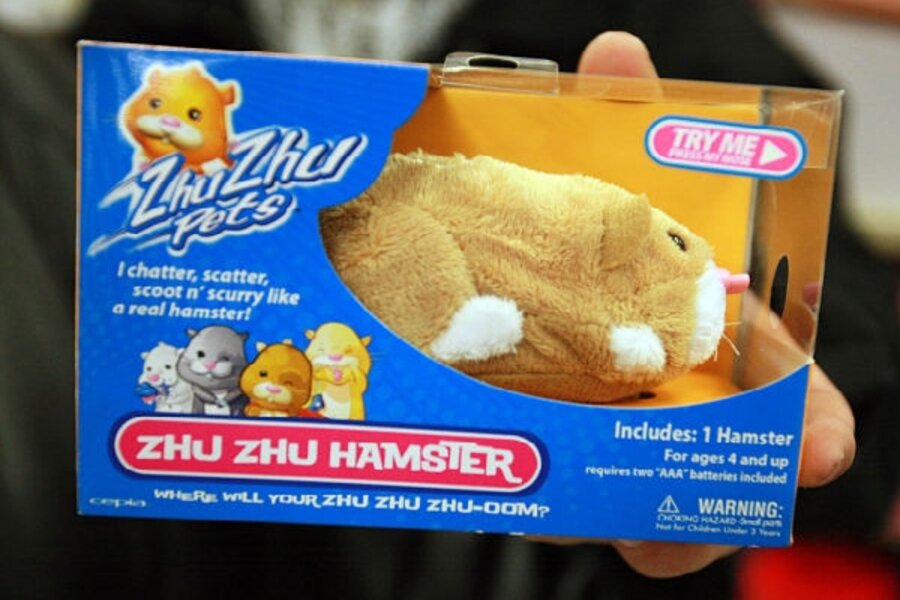Zhu Zhu Pets unsafe? Hardly, says manufacturer, as consumer group backtracks.
Loading...
When consumer-protection group GoodGuide raised questions about whether red-hot holiday gift Zhu Zhu Pets were unsafe, parents thronged the Internet to find out if the robotic hamsters were going to be recalled for what the consumer group called "dangerous" levels of tin and antimony.
However, GoodGuide has now posted a statement on its blog allowing that its testing methodology does not measure metals in the same way that American and European guidelines dictate.
The statement in part reads "while GoodGuide considers the presence of any antimony on the surface of a toy to be a concern, we want to clarify that we used a testing methodology to evaluate the toys that is different from the testing methodology incorporated into the federal standards."
Translation: The toys may not have violated national safety standards after all. The difference lies in how one counts trace amounts of metals.
Since there are no federal regulations for tin in toys, it's difficult to know what to make of GoodGuide's charge about that metal. On antimony, a substance used as a catalyst in polyester production and also sometimes as a flame retardant, US federal regulations limit the "soluble" amount of antimony in toys to 60 parts per million. The soluble standard involves the amount of antimony the product gives off when, for example, children put a toy in their mouths.
Cepia posted the safety review testing done by an international standards group on its website Monday, showing levels of soluble antimony in Zhu Zhu Pets under 2 parts per million.
By contrast, GoodGuide says it found levels of 103 parts per million of antimony on the nose of Mr. Squiggles, one of the most popular Zhu Zhu hamsters. The group also says it found 93 parts per million on Mr. Squiggles's fur, using a NITON XL3t series X-ray fluorescence (XRF) analyzer. But the XRF analysis measures total levels, not soluble levels.
While not speaking directly about GoodGuide's use of the analyzer, the director of product management at NITON manufacturer Thermo Fisher, says that the device is typically used as an initial scan to determine the presence of certain metals. It tells technicians whether more in-depth testing is necessary.
"It’s used for the first test in order to find out what’s in this sample to begin with. Obviously, if you don’t have any antimony to begin with, you don’t have to worry about whether its leachable or soluble," says David Mercuro of Thermo Fisher.
Mr. Mercuro said that the presence of a given substance in an initial scan did not have a bearing on whether the substance could be soluble.
Although GoodGuide's ranking of the popular Mr. Squiggles rates both antimony and tin content as "dangerous contents found," a disclaimer above the ratings says, "These levels are not intended to correspond to levels known to cause health effects. They are intended only to provide a relative measure of the level of the chemical in a toy product to which a child might be exposed."
In a statement released Monday afternoon, the CEO of Cepia LLC, the company that manufactures Zhu Zhu Pets, maintained that all the toy hamsters were in fact harmless.
"The claims made by GoodGuide have, unfortunately, caused great confusion with parents and regulators. I want to assure everyone who has purchased any Zhu Zhu Pets, or those planning to purchase one, that the toy is 100 percent safe," said CEO Russ Hornsby.
The Consumer Product Safety Commission (CPSC) announced Monday that it would be looking into the safety concerns of Zhu Zhu Pets, a move welcomed by Cepia.
"We fully embrace that," says company spokesman Grant Deady. "We’ve got a great relationship with the CPSC. They promised us they would expedite the testing process; we have a few people there onsite today to help them through it."
The CPSC did not return calls for comment.
Mr. Deady says Cepia had not been given a date by which the CPSC would conclude its testing.
"You have to put your trust into the industry and the government’s guidelines — which we follow — and not necessarily trust the source of some unqualified third party resource that doesn’t abide by the same guidelines as everyone else," Deady says.
GoodGuide did not return an e-mail request for comment.
See also:
Could a consumer's group report lead to a Zhu Zhu pet recall?
How to find a cheap Zhu Zhu pet
People making a difference: Dara O'Rourke, founder of GoodGuide
_____
— David Grant is a Monitor contributor. Are you keeping your Zhu Zhu? Sending it back to the store? Let us know on Twitter.





